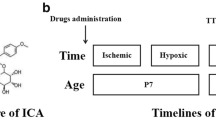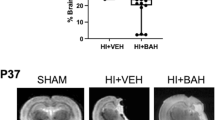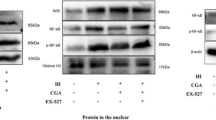Abstract
Purpose
Increasing evidence indicates that lithium is a neuroprotective agent against transient focal and global ischemic injury in the adult animal. In the developing brain, lithium has shown protective effects against neuroapoptosis induced by drugs. This study was designed to investigate the neuroprotective effects of lithium on hypoxic–ischemic brain injury in the neonatal rat.
Methods
Seven-day-old Sprague–Dawley rats underwent hypoxic–ischemic injury (HII) induced by ligation of the common carotid artery followed by exposure to ∼2.5 h of hypoxia (∼7% oxygen). After HII, rat pups were randomly assigned into two groups: a control group (n = 21), which received a daily subcutaneous injection of 0.9% normal saline for 14 days following HII; and a lithium group (n = 32), treated with daily injection of lithium chloride. N-acetylaspartate/creatinine, choline/creatinine, lipid/creatinine ratios at 1.3 ppm (Lip1.3/Cr) and 0.9 ppm (Lip0.9/Cr) lipid peaks were evaluated by proton magnetic resonance spectroscopy on the day of HII and on days 7 and 14 after HII. Infarct ratios based on magnetic resonance images were also determined at the same time points.
Results
Seven days after HII, the Lip1.3/Cr and Lip0.9/Cr ratios as well as the infarct ratio were significantly lower in the lithium group than in the control group. The Lip1.3/Cr and Lip0.9/Cr ratios were significantly correlated with infarct ratio.
Conclusion
This study showed that post-HII treatment with lithium may have a neuroprotective effect in the immature brain. Further studies are needed to elucidate the mechanism of neuroprotective properties of lithium against HII-induced neonatal brain damage.





Similar content being viewed by others
References
Bian Q, Shi T, Chuang DM, Qian Y (2007) Lithium reduces ischemia-induced hippocampal CA1 damage and behavioral deficits in gerbils. Brain Res 1184:270–276
Blankenberg FG, Storrs RW, Naumovski L, Goralski T, Spielman D (1996) Detection of apoptotic cell death by proton nuclear magnetic resonance spectroscopy. Blood 87:1951–1956
Brauer M (2003) In vivo monitoring of apoptosis. Prog Neuropsychopharmacol Biol Psychiatry 27:323–331
Cady EB, Penrice J, Amess PN, Lorek A, Wylezinska M, Aldridge RF, Franconi F, Wyatt JS, Reynolds EO (1996) Lactate, N-acetylaspartate, choline and creatine concentrations, and spin–spin relaxation in thalamic and occipito–parietal regions of developing human brain. Magn Reson Med 36:878–886
Calabresi P, Pisani A, Mercuri NB, Bernardi G (1993) Lithium treatment blocks long-term synaptic depression in the striatum. Neuron 10:955–962
Finley PR, Warner MD, Peabody CA (1995) Clinical relevance of drug interactions with lithium. Clin Pharmacokinet 29:172–191
Gasparovic C, Rosenberg GA, Wallace JA, Estrada EY, Roberts K, Pastuszyn A, Ahmed W, Graham GD (2001) Magnetic resonance lipid signals in rat brain after experimental stroke correlate with neutral lipid accumulation. Neurosci Lett 301:87–90
Ghribi O, Herman MM, Spaulding NK, Savory J (2002) Lithium inhibits aluminum-induced apoptosis in rabbit hippocampus, by preventing cytochrome c translocation, Bcl-2 decrease, Bax elevation and caspase-3 activation. J Neurochem 82:137–145
Girard N, Confort-Gouny S, Schneider J, Barberet M, Chapon F, Viola A, Pineau S, Combaz X, Cozzone P (2007) MR imaging of brain maturation. J Neuroradiol 34:290–310
Groenendaal F, Veenhoven RH, van der Grond J, Jansen GH, Witkamp TD, de Vries LS (1994) Cerebral lactate and N-acetyl-aspartate/choline ratios in asphyxiated full-term neonates demonstrated in vivo using proton magnetic resonance spectroscopy. Pediatr Res 35:148–151
Guo S, Arai K, Stins MF, Chuang DM, Lo EH (2009) Lithium upregulates vascular endothelial growth factor in brain endothelial cells and astrocytes. Stroke 40:652–655
Gwak M, Park P, Kim K, Lim K, Jeong S, Baek C, Lee J (2008) The effects of dantrolene on hypoxic–ischemic injury in the neonatal rat brain. Anesth Analg 106:227–233
Hakumaki JM, Poptani H, Sandmair AM, Yla-Herttuala S, Kauppinen RA (1999) 1H MRS detects polyunsaturated fatty acid accumulation during gene therapy of glioma: implications for the in vivo detection of apoptosis. Nat Med 5:1323–1327
Hakumaki JM, Brindle KM (2003) Techniques: visualizing apoptosis using nuclear magnetic resonance. Trends Pharmacol Sci 24:146–149
Harada K, Honmou O, Liu H, Bando M, Houkin K, Kocsis JD (2007) Magnetic resonance lactate and lipid signals in rat brain after middle cerebral artery occlusion model. Brain Res 1134:206–213
Hashimoto R, Hough C, Nakazawa T, Yamamoto T, Chuang DM (2002) Lithium protection against glutamate excitotoxicity in rat cerebral cortical neurons: involvement of NMDA receptor inhibition possibly by decreasing NR2B tyrosine phosphorylation. J Neurochem 80:589–597
Houkin K, Nakayama N, Kamada K, Noujou T, Abe H, Kashiwaba T (1998) Neuroprotective effect of the free radical scavenger MCI-186 in patients with cerebral infarction: clinical evaluation using magnetic resonance imaging and spectroscopy. J Stroke Cerebrovasc Dis 7:315–322
Huppi PS, Lazeyras F (2001) Proton magnetic resonance spectroscopy ((1)H-MRS) in neonatal brain injury. Pediatr Res 49:317–320
Juranek I, Baciak L (2009) Cerebral hypoxia–ischemia: focus on the use of magnetic resonance imaging and spectroscopy in research on animals. Neurochem Int 54:471–480
Kim KS, Park SJ, Lim KH, Kim EJ, Lee JH, Pi SY (2000) In vivo 1H MR spectroscopic analysis of apoptosis in hypoxic-ischemic newborn rats. Proc Intl Soc Mag Reson Med 8:1090
Kim YR, van Meer MP, Tejima E, Murata Y, Mandeville JB, Dai G, Chuang DM, Rosen BR, Lo EH (2008) Functional MRI of delayed chronic lithium treatment in rat focal cerebral ischemia. Stroke 39:439–447
Kreis R, Hofmann L, Kuhlmann B, Boesch C, Bossi E, Huppi PS (2002) Brain metabolite composition during early human brain development as measured by quantitative in vivo 1H magnetic resonance spectroscopy. Magn Reson Med 48:949–958
Li H, Li Q, Du X, Sun Y, Wang X, Kroemer G, Blomgren K, Zhu C (2011) Lithium-mediated long-term neuroprotection in neonatal rat hypoxia–ischemia is associated with antiinflammatory effects and enhanced proliferation and survival of neural stem/progenitor cells. J Cereb Blood Flow Metab 31:2106–2115
Li Q, Li H, Roughton K, Wang X, Kroemer G, Blomgren K, Zhu C (2010) Lithium reduces apoptosis and autophagy after neonatal hypoxia–ischemia. Cell Death Dis 1:e56
Lindskog M, Kogner P, Ponthan F, Schweinhardt P, Sandstedt B, Heiden T, Helms G, Spenger C (2003) Noninvasive estimation of tumour viability in a xenograft model of human neuroblastoma with proton magnetic resonance spectroscopy (1H MRS). Br J Cancer 88:478–485
Lorenz JM, Wooliever DE, Jetton JR, Paneth N (1998) A quantitative review of mortality and developmental disability in extremely premature newborns. Arch Pediatr Adolesc Med 152:425–435
Mikhailenko VM, Philchenkov AA, Zavelevich MP (2005) Analysis of 1H NMR-detectable mobile lipid domains for assessment of apoptosis induced by inhibitors of DNA synthesis and replication. Cell Biol Int 29:33–39
Nonaka S, Chuang DM (1998) Neuroprotective effects of chronic lithium on focal cerebral ischemia in rats. Neuroreport 9:2081–2084
Nonaka S, Hough CJ, Chuang DM (1998) Chronic lithium treatment robustly protects neurons in the central nervous system against excitotoxicity by inhibiting N-methyl-d-aspartate receptor-mediated calcium influx. Proc Natl Acad Sci U S A 95:2642–2647
Omata N, Murata T, Takamatsu S, Maruoka N, Mitsuya H, Yonekura Y, Fujibayashi Y, Wada Y (2008) Neuroprotective effect of chronic lithium treatment against hypoxia in specific brain regions with upregulation of cAMP response element binding protein and brain-derived neurotrophic factor but not nerve growth factor: comparison with acute lithium treatment. Bipolar Disord 10:360–368
Palmer C, Vannucci RC, Towfighi J (1990) Reduction of perinatal hypoxic–ischemic brain damage with allopurinol. Pediatr Res 27:332–336
Peden CJ, Rutherford MA, Sargentoni J, Cox IJ, Bryant DJ, Dubowitz LM (1993) Proton spectroscopy of the neonatal brain following hypoxic–ischaemic injury. Dev Med Child Neurol 35:502–510
Pi SY, Kim KS, Yoon KH, Yoon HS, Lim KH, Kim EJ, Lee JH (2000) Investigation of hypoxic-ischemic injured newborn rat brain by in vivo 1H MR spectroscopy. Proc Intl Soc Mag Reson Med 8:1093
Rice JE 3rd, Vannucci RC, Brierley JB (1981) The influence of immaturity on hypoxic–ischemic brain damage in the rat. Ann Neurol 9:131–141
Serrai H, Senhadji L, Wang G, Akoka S, Stroman P (2003) Lactate doublet quantification and lipid signal suppression using a new biexponential decay filter: application to simulated and 1H MRS brain tumor time-domain data. Magn Reson Med 50:623–626
Straiko MM, Young C, Cattano D, Creeley CE, Wang H, Smith DJ, Johnson SA, Li ES, Olney JW (2009) Lithium protects against anesthesia-induced developmental neuroapoptosis. Anesthesiology 110:862–868
Strbian D, Tatlisumak T, Ramadan UA, Lindsberg PJ (2007) Mast cell blocking reduces brain edema and hematoma volume and improves outcome after experimental intracerebral hemorrhage. J Cereb Blood Flow Metab 27:795–802
Swanson RA, Morton MT, Tsao-Wu G, Savalos RA, Davidson C, Sharp FR (1990) A semiautomated method for measuring brain infarct volume. J Cereb Blood Flow Metab 10:290–293
Vannucci RC, Vannucci SJ (1997) A model of perinatal hypoxic–ischemic brain damage. Ann N Y Acad Sci 835:234–249
Vannucci RC, Vannucci SJ (2005) Perinatal hypoxic–ischemic brain damage: evolution of an animal model. Dev Neurosci 27:81–86
Xu J, Culman J, Blume A, Brecht S, Gohlke P (2003) Chronic treatment with a low dose of lithium protects the brain against ischemic injury by reducing apoptotic death. Stroke 34:1287–1292
Yan XB, Hou HL, Wu LM, Liu J, Zhou JN (2007) Lithium regulates hippocampal neurogenesis by ERK pathway and facilitates recovery of spatial learning and memory in rats after transient global cerebral ischemia. Neuropharmacology 53:487–495
Yan XB, Wang SS, Hou HL, Ji R, Zhou JN (2007) Lithium improves the behavioral disorder in rats subjected to transient global cerebral ischemia. Behav Brain Res 177:282–289
Young C, Straiko MM, Johnson SA, Creeley C, Olney JW (2008) Ethanol causes and lithium prevents neuroapoptosis and suppression of pERK in the infant mouse brain. Neurobiol Dis 31:355–360
Disclosure statement
The authors declare that they have no conflicts of interest.
Funding source
This work was supported by a grant from Asan Institute for Life Sciences (Seoul, Korea).
Author information
Authors and Affiliations
Corresponding author
Rights and permissions
About this article
Cite this article
Shin, WJ., Gwak, M., Baek, CH. et al. Neuroprotective effects of lithium treatment following hypoxic–ischemic brain injury in neonatal rats. Childs Nerv Syst 28, 191–198 (2012). https://doi.org/10.1007/s00381-011-1627-2
Received:
Accepted:
Published:
Issue Date:
DOI: https://doi.org/10.1007/s00381-011-1627-2




